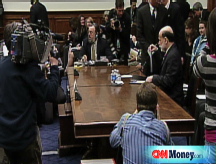Watch what the Fed says...
not what it does. With the market expecting the central bank to keep rates at 2%, investors will focus closely on the wording of the Fed's statement.


NEW YORK (CNNMoney.com) -- The Fed's words will speak louder than its actions this afternoon.
It's all but certain the central bank is going to sit tight at 2:15 ET and keep its key federal funds rate at 2%. There's a better chance of "The Love Guru" winning next year's Oscar for Best Picture than of an interest rate hike or cut today.
But what the Fed says in its accompanying statement will be crucial.
With inflation fears on the rise, there is growing speculation that the Fed may begin to raise rates as soon as its next meeting on Aug. 5. Many economists think that would be too soon, however, because the economy is still in a precarious state, and higher rates would kill any chance for a recovery.
So how should you parse the Fed's statement? Here are some key things to look out for.
In the statement following its last meeting in April, the Fed set the stage for a pause today by saying that "the substantial easing of monetary policy to date, combined with ongoing measures to foster market liquidity, should help to promote moderate growth over time and to mitigate risks to economic activity."
If that phrase, or something similar to it, remains in today's statement, that's probably a sign that the Fed will remain on hold for a while. It's signaling that it thinks its seven rate cuts since last September and series of loans to banks should help put an end to the credit crunch.
However, people will also be looking for clues as to how serious the Fed is considering raising rates.
It seems likely that the Fed will show more concerns about inflation. In the April statement, the central bank did not seem too alarmed about the big increase in commodities prices.
The Fed acknowledged that "energy and other commodity prices have increased, and some indicators of inflation expectations have risen in recent months." But it also noted that it "expects inflation to moderate in coming quarters, reflecting a projected leveling-out of energy and other commodity prices."
But oil prices have soared 20% since the Fed's last meeting.
"The perception is that the inflation situation is worse. They will lean more on the inflation risk in this statement," said John Derrick, director of research with U.S. Global Investors Inc., an investment firm based in San Antonio. "They may hint at rate hikes down the road."
It's also worth noting that the dollar hasn't done much against the euro since the last meeting, rising just 1%. (Some market experts blame the Fed's rate cuts for weakening the dollar and spurring the boom in oil and other commodity prices.)
So could the Fed actually do the unthinkable and mention the dollar specifically in its statement?
The central bank has typically avoided talking about the dollar. But that's been changing. In a speech earlier this month, Fed chairman Ben Bernanke said the Fed would be "attentive to the implications of changes in the value of the dollar for inflation."
Richard Sparks, a senior equities analyst with Schaeffer's Investment Research in Cincinnati, said he's not sure the Fed would go so far to talk about currency in the statement.
"The Fed has been trying to talk up the dollar. But it's one thing to do so when giving speeches and another to make it part of an official policy statement," he said.
Nonetheless, traders will be monitoring the statement closely for any discussion of the dollar.
Ashraf Laidi, chief currency strategist with investment brokerage CMC Markets US, wrote in a note to clients yesterday that "in the event that the Fed mentions the dollar in the statement," he would expect the euro to fall against the dollar.
One euro currently equals about $1.56. Laidi wrote that if the Fed talks about the dollar, the exchange rate could go as low as about $1.538 dollars per euro.
But he thinks another dollar defense is unlikely. After all, despite the concerns about inflation, the Fed can't completely rule out a rate cut down the road either since many of the other factors the Fed talked about in April have not improved.
"Household and business spending has been subdued and labor markets have softened further. Financial markets remain under considerable stress, and tight credit conditions and the deepening housing contraction are likely to weigh on economic growth over the next few quarters," the Fed said in April.
And since then, the unemployment rate has shot up to 5.5%, consumer confidence has plunged, housing prices and sales have dropped and the broader stock market indices are trading lower.
Add all that up and the Fed has an unenviable task.
"The Fed is caught right now with a fight on two fronts - the weak dollar and inflation on one side and the slowing economy on the other side," said Sparks. "I'm not sure what the Fed can do or say now to have a desired effect at this point."
Issue #1 - America's Money: All this week at noon ET, CNN explains how the weakening economy affects you. Full coverage.
Gas prices have climbed to record levels. Are you feeling the pinch? Tell us how gas prices are affecting you and what you're doing to cope. Send us your photos and videos, or email us and tell us what you think. ![]()




